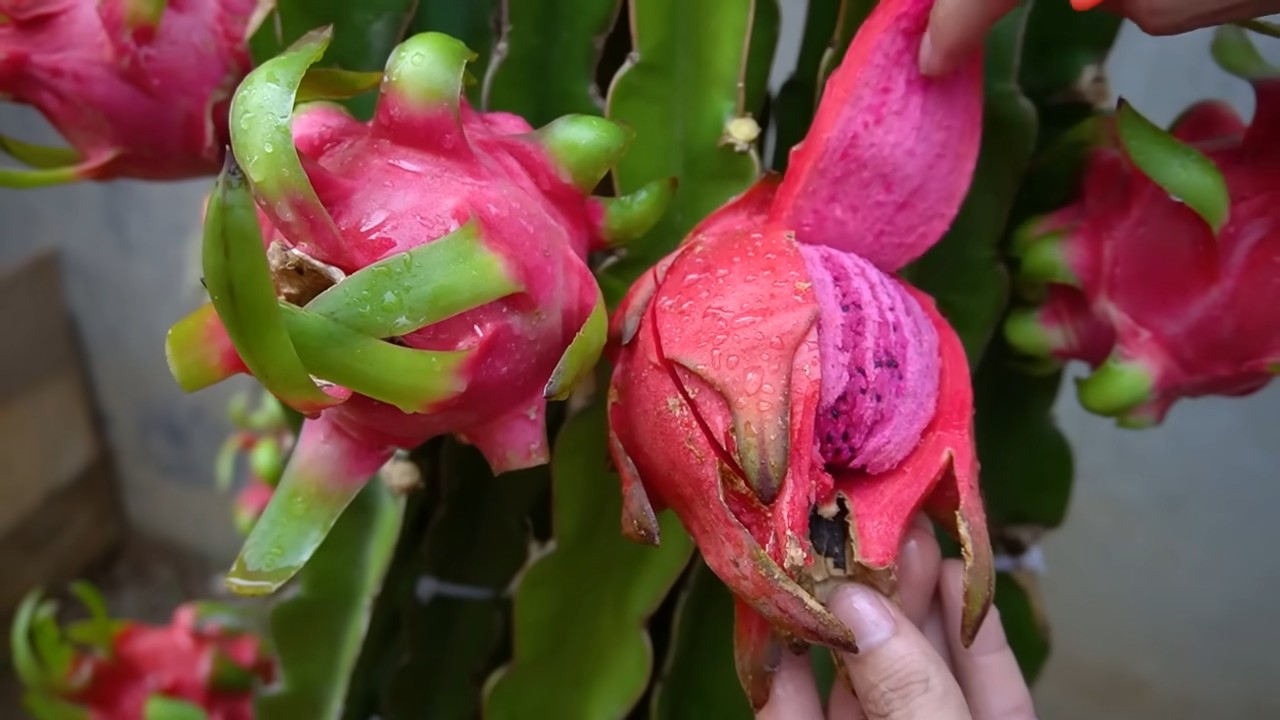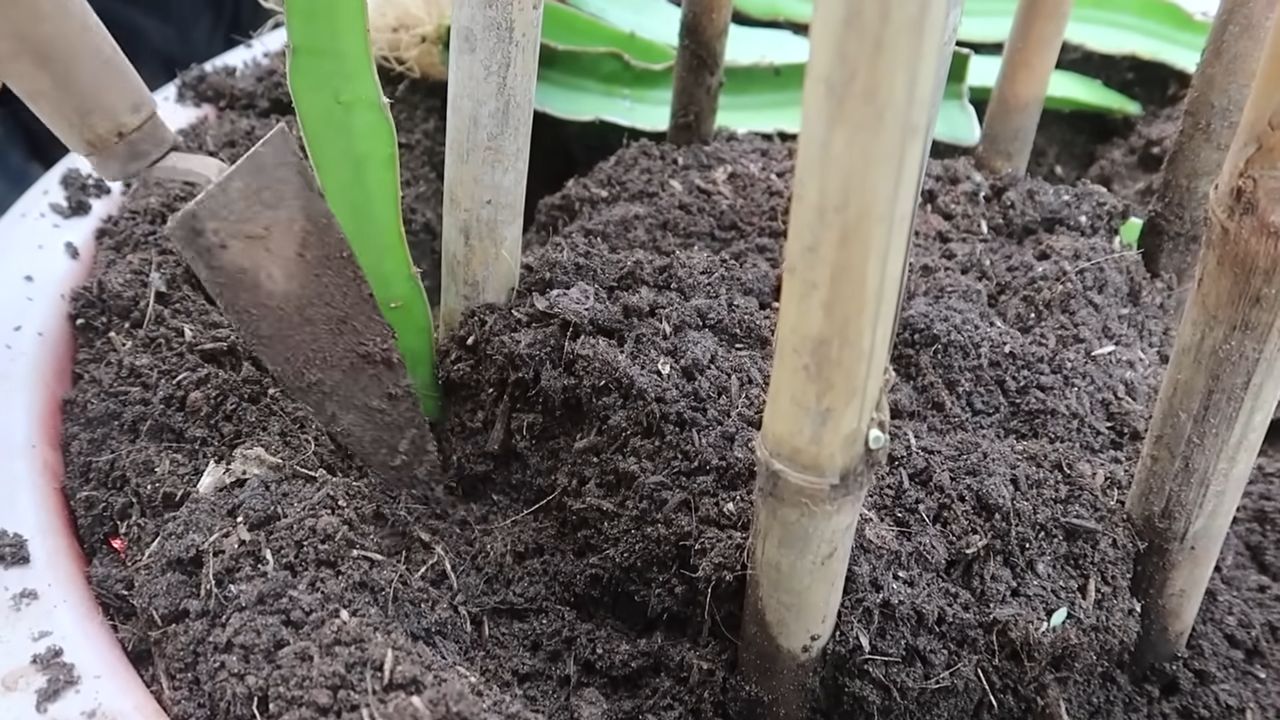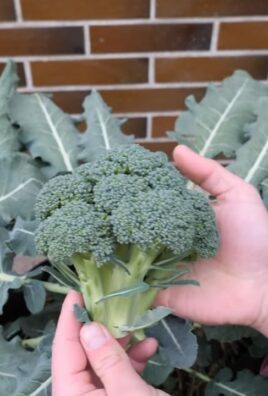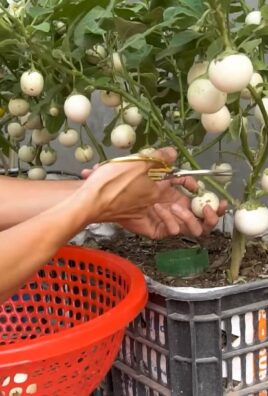Growing Red Dragon Fruit at home might sound like an exotic dream, reserved for tropical climates and expert gardeners. But I’m here to tell you that with a few clever tricks and a little DIY spirit, you can absolutely cultivate this vibrant and delicious fruit right in your own backyard or even on your balcony!
The Red Dragon Fruit, also known as Pitaya, has a fascinating history, originating in Central America and making its way to Southeast Asia, where it’s now widely cultivated. In many cultures, it’s considered a symbol of good fortune and prosperity, often gifted during special occasions. Imagine the joy of sharing your own homegrown symbol of good luck!
But beyond its cultural significance, why should you bother with this DIY project? Well, store-bought Dragon Fruit can be expensive and sometimes lacks the intense flavor of a freshly picked one. Plus, there’s immense satisfaction in nurturing a plant from a small cutting to a fruit-bearing beauty. This article is packed with simple, effective DIY hacks that will demystify the process of growing Red Dragon Fruit, even if you’re a beginner. I’ll guide you through everything from choosing the right variety and preparing the soil to providing the necessary support and protecting your precious plants from pests. Get ready to embark on a rewarding gardening adventure and enjoy the sweet taste of success!

DIY: Propagating and Growing Your Own Red Dragon Fruit
Hey there, fellow plant enthusiasts! Ever dreamt of harvesting your own vibrant, exotic red dragon fruit? Well, dream no more! I’m here to guide you through the surprisingly simple process of propagating and growing your own dragon fruit right at home. It’s a rewarding experience, and trust me, that first homegrown dragon fruit tastes like pure victory!
Choosing Your Dragon Fruit Cutting
Before we dive into the nitty-gritty, let’s talk about getting your hands on a good cutting. This is the foundation of your dragon fruit journey, so choose wisely!
* Source Matters: Ideally, get your cutting from a healthy, mature dragon fruit plant that produces delicious fruit. Ask friends, neighbors, or check local nurseries. A cutting from a proven producer is more likely to give you the same results.
* Cutting Size: Look for cuttings that are at least 12 inches long, but longer is better! A 12-24 inch cutting is a good starting point. Longer cuttings have more stored energy and are more likely to root successfully.
* Healthy Appearance: The cutting should be firm, green, and free from any signs of disease or pests. Avoid cuttings that are yellowing, shriveled, or have any suspicious spots.
* Age of the Cutting: A slightly aged cutting is better than a very fresh one. Let the cut end callous over for a few days before planting. This helps prevent rot.
Preparing Your Dragon Fruit Cutting for Planting
Okay, you’ve got your cutting! Now, let’s get it ready for its new home.
1. Clean the Cutting: Gently wash the cutting with water to remove any dirt or debris. You can use a soft brush if needed.
2. Callousing the Cut End: This is crucial! Place the cutting in a dry, shaded area for 3-7 days to allow the cut end to callous over. This forms a protective barrier against rot. I usually lean mine against a wall in my garage.
3. Optional: Rooting Hormone: While not essential, dipping the cut end in rooting hormone can speed up the rooting process. Follow the instructions on the rooting hormone package. I’ve had success both with and without it, so don’t stress if you don’t have any.
Planting Your Dragon Fruit Cutting
Alright, time to get our hands dirty!
1. Choose the Right Pot: Select a pot that is at least 10-12 inches in diameter. Dragon fruit needs room for its roots to grow. Make sure the pot has drainage holes!
2. Prepare the Soil: Dragon fruit prefers well-draining soil. A mix of cactus potting mix, perlite, and a little bit of compost works wonders. I usually go for a 1:1:1 ratio.
3. Planting Depth: Plant the calloused end of the cutting about 2-3 inches deep in the soil.
4. Support System: Dragon fruit is a climbing cactus, so it needs support. Insert a sturdy stake or trellis into the pot near the cutting. This will give it something to climb as it grows. A simple wooden stake works great.
5. Watering: Water the soil thoroughly after planting, but don’t overwater! Dragon fruit is susceptible to root rot. Let the soil dry out slightly between waterings.
Caring for Your Dragon Fruit Plant
Now comes the waiting game, but don’t worry, there are things you can do to ensure your dragon fruit thrives!
1. Sunlight: Dragon fruit loves sunlight! Place your pot in a location that receives at least 6-8 hours of direct sunlight per day. A south-facing window or a sunny patio is ideal.
2. Watering: Water your dragon fruit plant when the top inch of soil feels dry. During the growing season (spring and summer), you may need to water more frequently. Reduce watering during the dormant season (fall and winter).
3. Fertilizing: Feed your dragon fruit plant with a balanced fertilizer every 2-3 months during the growing season. Look for a fertilizer that is specifically formulated for cacti or succulents. I use a 10-10-10 fertilizer diluted to half strength.
4. Pruning: Prune your dragon fruit plant regularly to encourage branching and fruit production. Remove any dead or damaged stems. You can also prune to control the size and shape of the plant.
5. Pest Control: Keep an eye out for pests such as aphids, mealybugs, and scale. If you spot any pests, treat them with insecticidal soap or neem oil.
6. Temperature: Dragon fruit prefers warm temperatures. It can tolerate temperatures as low as 32掳F (0掳C) for short periods, but it’s best to keep it above 50掳F (10掳C). If you live in a cold climate, you may need to bring your dragon fruit plant indoors during the winter.
Training Your Dragon Fruit Plant
Training your dragon fruit is essential for maximizing fruit production. It encourages branching and creates a strong, supportive structure.
1. Initial Growth: As your dragon fruit plant grows, it will send out long, trailing stems. Gently tie these stems to the stake or trellis using soft plant ties.
2. Encouraging Branching: Once the main stem reaches the top of the support, prune the tip to encourage branching. This will create a “head” of branches at the top of the support.
3. Creating a “Head”: The “head” of branches is where the flowers and fruit will develop. Prune the branches in the “head” to maintain a manageable size and shape.
4. Removing Suckers: Remove any suckers that grow from the base of the plant. These suckers will compete with the main plant for resources.
Pollinating Your Dragon Fruit Flowers
Dragon fruit flowers are nocturnal, meaning they bloom at night. They are also self-sterile, meaning they need to be cross-pollinated with another dragon fruit plant to produce fruit.
1. Hand Pollination: If you only have one dragon fruit plant, you will need to hand-pollinate the flowers. Use a small paintbrush to transfer pollen from the stamen (male part) of one flower to the pistil (female part) of another flower.
2. Timing is Key: Pollinate the flowers as soon as they open, usually around midnight. The flowers only stay open for one night.
3. Multiple Plants: If you have multiple dragon fruit plants, you can encourage natural pollination by attracting pollinators such as moths and bats. Plant fragrant flowers near your dragon fruit plants to attract these pollinators.
Harvesting Your Dragon Fruit
After successful pollination, it takes about 30-50 days for the fruit to ripen.
1. Ripeness Indicators: The fruit is ripe when it turns a vibrant red or pink color and the “wings” (the scales on the fruit) start to dry out. The fruit should also feel slightly soft to the touch.
2. Harvesting: Use a sharp knife or pruners to cut the fruit from the stem. Be careful not to damage the plant.
3. Enjoying Your Harvest: Cut the dragon fruit in half and scoop out the flesh with a spoon. You can eat it fresh, add it to smoothies, or use it in desserts.
Troubleshooting Common Dragon Fruit Problems
Even with the best care, you might encounter some challenges along the way. Here are a few common problems and how to address them:
* Root Rot: This is usually caused by overwatering. Make sure your soil is well-draining and allow the soil to dry out slightly between waterings. If you suspect root rot, repot the plant in fresh soil and remove any rotten roots.
* Yellowing Leaves: This can be caused by a variety of factors, including overwatering, underwatering, nutrient deficiencies, or pests. Check the soil moisture and adjust your watering accordingly. Fertilize the plant with a balanced fertilizer. Inspect the plant for pests and treat them as needed.
* Lack of Flowering: This can be caused by insufficient sunlight, lack of nutrients, or improper pruning. Make sure your plant is getting enough sunlight. Fertilize the plant with a fertilizer that is high in phosphorus. Prune the plant to encourage branching and fruit production.
* Fruit Splitting: This can be caused by inconsistent watering or excessive rainfall. Try to maintain consistent soil moisture. If you live in an area with heavy rainfall, consider covering the plant with a tarp during rainy periods.
Propagating from Seed (Advanced)
While propagating from cuttings is the easiest and most reliable method, you can also try growing dragon fruit from seed. However, keep in mind that plants grown from seed may not produce fruit that is true to the parent plant.
1. Extracting Seeds: Cut open a ripe dragon fruit and scoop out the flesh. Separate the seeds from the pulp by rinsing them in water.
2. Drying the

Conclusion
So, there you have it! Growing Red Dragon Fruit at home might seem like a tropical dream, but with a little patience, the right knowledge, and a dash of dedication, it’s entirely achievable. We’ve walked you through the essential steps, from selecting the perfect cutting to providing the ideal support structure and nurturing your plant to maturity.
But why should you embark on this exciting journey? Beyond the sheer satisfaction of cultivating your own exotic fruit, growing Red Dragon Fruit offers a unique opportunity to connect with nature, learn about plant life cycles, and enjoy the unparalleled flavor of homegrown produce. Store-bought dragon fruit simply can’t compare to the vibrant taste and juicy texture of a fruit ripened on your own vine. Plus, you’ll have the bragging rights of being a dragon fruit grower!
This isn’t just about having a pretty plant; it’s about embracing a sustainable lifestyle, reducing your carbon footprint by sourcing locally (from your own backyard!), and enjoying the health benefits of fresh, organic fruit. Red Dragon Fruit is packed with antioxidants, vitamins, and fiber, making it a delicious and nutritious addition to your diet.
Don’t be afraid to experiment! Consider different trellis designs to suit your space and aesthetic preferences. Try grafting different varieties of dragon fruit onto a single plant for a diverse harvest. Explore companion planting to attract pollinators and deter pests naturally. You can even try growing your dragon fruit in a container if you have limited space, just ensure it’s a large pot with excellent drainage.
We encourage you to take the plunge and start your own Red Dragon Fruit growing adventure. The rewards are well worth the effort. Imagine the vibrant colors of the fruit, the sweet aroma filling your garden, and the satisfaction of sharing your homegrown treasure with friends and family.
Once you’ve successfully harvested your first dragon fruit, we’d love to hear about your experience! Share your photos, tips, and challenges in the comments below. Let’s build a community of dragon fruit enthusiasts and learn from each other’s successes and failures. Your insights could inspire others to embark on their own growing journey. Remember, every gardener starts somewhere, and even small steps can lead to big harvests. So, grab your gardening gloves, find a sunny spot, and get ready to experience the magic of growing Red Dragon Fruit!
Frequently Asked Questions (FAQ)
What is the best time of year to plant Red Dragon Fruit cuttings?
The ideal time to plant Red Dragon Fruit cuttings is during the late spring or early summer. This allows the cuttings to establish themselves during the warm growing season, giving them ample time to develop a strong root system before the cooler months arrive. Avoid planting during the winter months, as the cold temperatures can hinder root development and potentially damage the cuttings. If you live in a region with mild winters, you may be able to plant in early fall, but be sure to provide adequate protection from frost.
How much sunlight does Red Dragon Fruit need?
Red Dragon Fruit thrives in full sun, requiring at least six to eight hours of direct sunlight per day. Adequate sunlight is crucial for optimal growth, flowering, and fruit production. If your plant doesn’t receive enough sunlight, it may become leggy, produce fewer flowers, and the fruit may not ripen properly. If you’re growing your dragon fruit indoors, supplement with grow lights to ensure it receives sufficient light.
What kind of soil is best for Red Dragon Fruit?
Red Dragon Fruit prefers well-draining soil that is rich in organic matter. A slightly acidic to neutral pH (6.0-7.0) is ideal. Avoid heavy clay soils, as they can retain too much moisture and lead to root rot. Amend your soil with compost, aged manure, or other organic materials to improve drainage and fertility. You can also use a cactus or succulent potting mix, which is specifically formulated for plants that prefer well-draining soil.
How often should I water my Red Dragon Fruit plant?
Water your Red Dragon Fruit plant deeply but infrequently, allowing the soil to dry out slightly between waterings. Overwatering is a common mistake that can lead to root rot. The frequency of watering will depend on factors such as the climate, soil type, and size of the plant. During the hot summer months, you may need to water more frequently, while during the cooler months, you can reduce watering. Check the soil moisture level before watering by inserting your finger into the soil. If the top inch or two feels dry, it’s time to water.
How do I fertilize my Red Dragon Fruit plant?
Fertilize your Red Dragon Fruit plant regularly during the growing season (spring and summer) with a balanced fertilizer. A fertilizer with an NPK ratio of 10-10-10 or 15-15-15 is a good choice. Follow the instructions on the fertilizer label for application rates. You can also use organic fertilizers such as compost tea or fish emulsion. Avoid over-fertilizing, as this can damage the plant. Reduce or stop fertilizing during the dormant season (fall and winter).
How long does it take for Red Dragon Fruit to produce fruit?
Red Dragon Fruit plants typically start producing fruit within one to two years of planting, provided they are grown under optimal conditions. However, it can take up to three years for some plants to mature and bear fruit. Factors such as the variety of dragon fruit, climate, soil conditions, and care practices can all influence the time it takes for the plant to fruit.
What kind of support structure does Red Dragon Fruit need?
Red Dragon Fruit is a climbing cactus that requires a strong support structure to grow properly. A sturdy trellis, post, or fence is essential. The support structure should be at least six to eight feet tall to accommodate the plant’s growth. As the plant grows, tie the stems to the support structure to encourage vertical growth. A circular trellis at the top of the support is ideal for the branches to cascade over, which encourages flowering and fruiting.
How do I pollinate Red Dragon Fruit flowers?
Most Red Dragon Fruit varieties are self-pollinating, meaning they can pollinate themselves. However, cross-pollination with another variety can often result in larger and more flavorful fruit. If you want to ensure pollination, you can hand-pollinate the flowers. Use a small paintbrush to transfer pollen from the stamen (male part) of one flower to the stigma (female part) of another flower. The flowers typically open at night and close in the morning, so hand-pollination is best done in the evening or early morning.
What are some common pests and diseases that affect Red Dragon Fruit?
Red Dragon Fruit is generally resistant to pests and diseases, but it can be susceptible to certain problems. Common pests include aphids, mealybugs, and scale insects. These pests can be controlled with insecticidal soap or neem oil. Root rot is a common disease that can occur if the plant is overwatered or grown in poorly draining soil. Prevent root rot by ensuring proper drainage and avoiding overwatering. Fungal diseases can also affect Red Dragon Fruit, especially in humid climates. Treat fungal diseases with a fungicide.
How do I harvest Red Dragon Fruit?
Red Dragon Fruit is typically ready to harvest about 30-50 days after flowering. The fruit is ripe when the skin turns a bright, even color and the “wings” or bracts on the fruit start to dry out. The fruit should also feel slightly soft to the touch. To harvest, simply twist the fruit off the stem. Be careful not to damage the plant when harvesting. Store the harvested fruit in the refrigerator for up to a week.





Leave a Comment